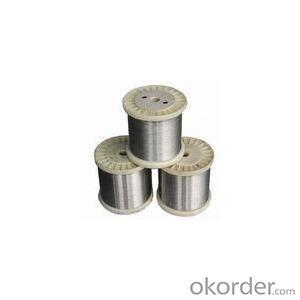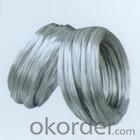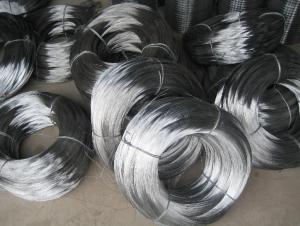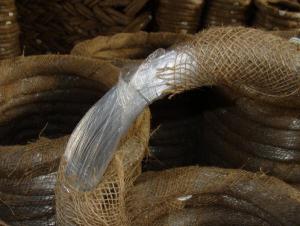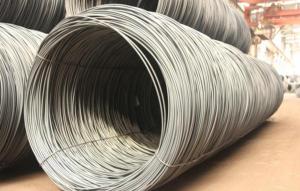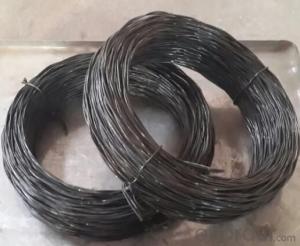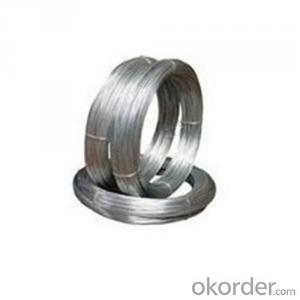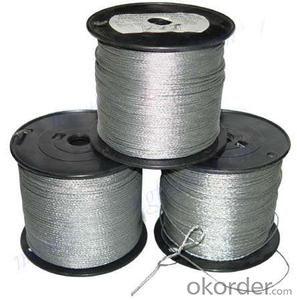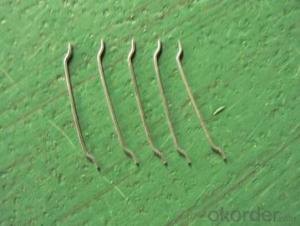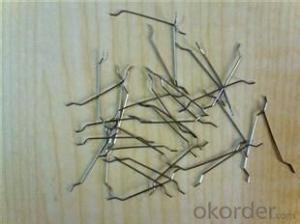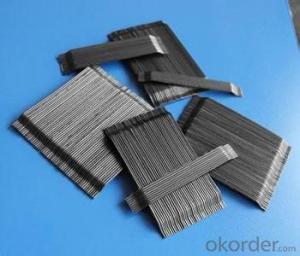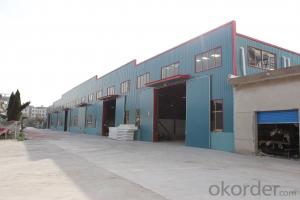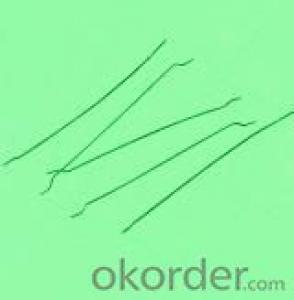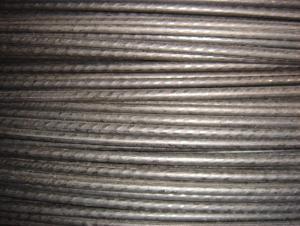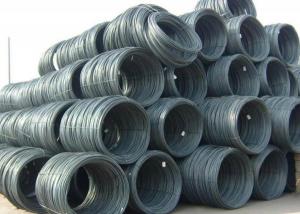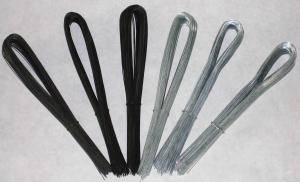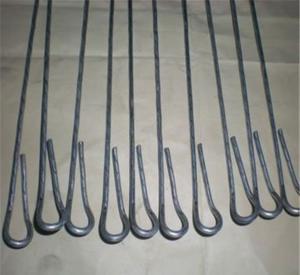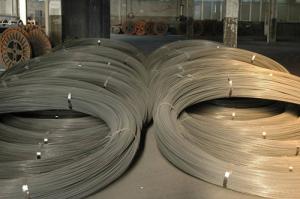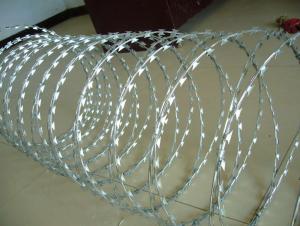Prefab construction material steel fiber
- Loading Port:
- Tianjin
- Payment Terms:
- TT OR LC
- Min Order Qty:
- 1 m.t.
- Supply Capability:
- 10000 m.t./month
OKorder Service Pledge
Quality Product, Order Online Tracking, Timely Delivery
OKorder Financial Service
Credit Rating, Credit Services, Credit Purchasing
You Might Also Like
Quick Details
Place of Origin: Tianjin, China (Mainland)
- Model Number: 0.55
Material: Steel
Production Process: Cold drawn
Fiber Lengh: 35
Type: 1
Compressive Strength: >1200MPa
Aspect ratio: 63
Standard: ASTM A820M-11
Section Shape: Circular
Application: Concrete Reinforcement
Producing Area: Tianjin
Product Application: Industrial Floor
Packaging & Delivery
| Packaging Details: | 20 kg/Bag,50 bags/Pallet or 1,000kg/ Bulk Bag |
|---|---|
| Delivery Detail: | 1 Month |
Specifications
1.Deformed cold-drawn wire,Hooked-end
2.Aspect ratio:60-80
3.Tensile:1200Mpa
4.Diameter:0.5-0.9mm
5.Length:30-60mm
Product Description
| Diameter | 0.55 mm (0.217 in) | ||
| Length | 35 mm (13.780 in) | ||
| Aspect Ratio | 63 | ||
| Tensile strength | 1200 MPa | ||
| Type | Cold drawn Steel Fiber | ||
| End | Hooked-end Steel Fiber | ||
| Glued/Loose | Glued Steel Fiber | ||
| Bending Angle | 45°(min.30°) | ||
| Usage & Performance | Floor:Trafficked areas and Industrial floors | ||
| Shotcrete :Slope stabilization and Final lining | |||
| Precast concrete:Pipe and Railway sleepers | |||
| Packing | Standard Export Pallet Packing | Bag Packing | 20 kg/Bag,50 bags/Pallet |
| Bulk Packing | 1,000kg/ Bulk Bag | ||
| Loading Quantity | 20’GP | 20-25 Tonne/Tonnes | |
| 40’GP | 25-27 Tonne/Tonnes | ||
| 40’HQ | 25-27 Tonne/Tonnes | ||
| MOQ | 1 kg for trial order | ||
| Supply Ability | 10,000 Tonne/Tonnes per Year | ||
| Payment Terms | T/T or L/C at sight | ||
| Delivery Time | Within 15 days after receiving deposit or original L/C at sight | ||
| Certification | ISO9001:2000, CE, | ||
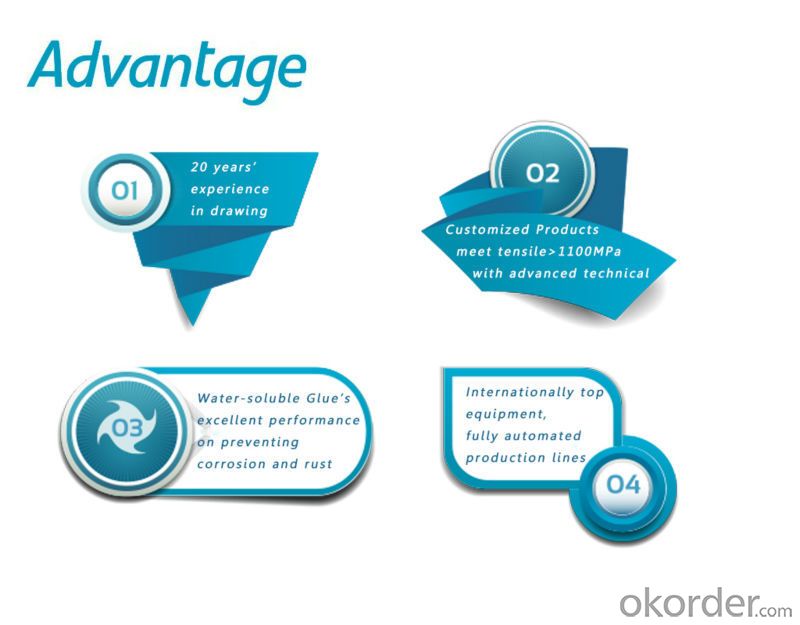
| Product | Diameter | Length mm/in | Aspect Ratio | Type | Packing |
| G-6030 | 0.5 mm (0.197 in) | 30 mm (11.811 in) | 60 | Glued | 20 kg/Bag, or 1,000kg/ Bulk Bag |
| G-6535 | 0.55 mm (0.217 in) | 35 mm (13.780 in) | 65 | Glued | 20 kg/Bag, or 1,000kg/ Bulk Bag |
| G-6035 | 0.6 mm (0.236 in) | 35 mm (13.780 in) | 60 | Glued | 20 kg/Bag, or 1,000kg/ Bulk Bag |
| G-8060 | 0.75 mm (0.295 in) | 60 mm (23.622 in) | 80 | Glued | 20 kg/Bag, 50 bags/Pallet |
| G-6060 | 0.9 mm (0.354 in) | 60 mm (23.622 in) | 60 | Glued | 20 kg/Bag, 50 bags/Pallet |
| G-6030 | 0.5 mm (0.197 in) | 30 mm (11.811 in) | 60 | Loose | 20 kg/Bag, or 1,000kg/ Bulk Bag |
| G-6535 | 0.55 mm (0.217 in) | 35 mm (13.780 in) | 65 | Loose | 20 kg/Bag, or 1,000kg/ Bulk Bag |
| G-6035 | 0.6 mm (0.236 in) | 35 mm (13.780 in) | 60 | Loose | 20 kg/Bag, or 1,000kg/ Bulk Bag |
| G-8060 | 0.75 mm (0.295 in) | 60 mm (23.622 in) | 80 | Loose | 20 kg/Bag, 50 bags/Pallet |
| G-6060 | 0.9 mm (0.354 in) | 60 mm (23.622 in) | 60 | Loose | 20 kg/Bag, 50 bags/Pallet |
- Q: A horizontal current-carrying wire, free to move in Earth’s gravitational field, is suspended directly above a second, parallel, current-carrying wire. (a) In what direction is the current in the lower wire? (b) Can the upper wire be held in stable equilibrium due to the magnetic force of the lower wire? Explain.I assume they travel in opposite directions if they are both charged the same, but I think my instructor wants something more specific. Any help is much appreciated.
- Current carrying wire does not have extra charge but only flow So there is no electrostatic force between them. The magnetic force is present only when current flows through both wires. If it flows in the same direction then they attract. So if the lower wire is fixed and you wish to suspend the above it must repel it to overcome the gravitational force due to earth acting on it. Hence the wires must carry currents in opposite direction.
- Q: first wire change
- Depends on how many little kinks he's putting in it. Also depends on how fast he works, if your wire needs a lot of work or a little, and if he already has an idea of what he wants to do or if he's just guessing along the way. It shouldn't take longer for him to make the actual kinks than it does the remove and replace the wire. That's a little more labor intensive and can take about 5-10 minutes for each wire. The whole thing, uninterrupted might last 30-45 minutes.
- Q: hey im wiring up a headunit to my L300 van. The factory headunit wasnt there and im having trouble connecting which colour wires to the factory colour wires. if anyone knows which coulours go to what would be much appreciatedcheers.
- Hi does anyone knows where the stereo looms connect back to .i.e. fused?
- Q: my old light fixture had 2 white wires (from ceiling) twisted together and connected to a screw, it also had a green wire (from ceiling)connected to it with a screw.no black wires were connected to light fixture although they are 3 wires in the ceiling taped off together.how do i test for hot wire, i got a tester that lights up.i got a new light fixture that has 3 wires, 1 wht 1blk and copper.i know the copper goes with green, white with white and black with black. so i untangled the black wires, and i connected one to new light.but now my new light doesnt turn off.so i know i by passed my switch.how do i test for hot wire....where does the hot wire go?is it possible one of the white wires is my hot wire and the other white whire my neutral....so help please, im confused and frustrated
- It sounds like the old fixture may have been improperly wired. It should not have had the green wire going to one side (screw) with the white wires going to the other side of the fixture. The green wire is normally a ground, and is only connected to the housing of the fixture - it's purpose is solely for safety, in case the hot side comes in contact with the metal fixture housing (it blows the breaker by design rather than being an electrocution hazard). Typically, the hot (black) wire is switched, and the neutrals bypass the switch. Your best bet is to search online for a wiring diagram for a switched light fixture, print it out and working with your test light, find the switched hot wire by measuring from each wire to the ground wire (for convenience only - hopefully it is really grounded) with the switch set in both directions. Note the results on the diagram, and that should help you sort it out.
- Q: What role does the neutral wire play?
- It provides the return current path. Without it positive current would have no where to flow once it enters a device. Here's why: Think about you sink... you need a pipe to bring the water in, this is the hot wire. Without a drain the water has no where to go to, this is the neutral wire. Without a drain there is no net flow of water.
- Q: Ok I've been changing the old outlets in the house and all of them were fine until I got to this 1 outlet. The outlet had 1 ground wire, 2 white and 2 black (if that helps). The wires were a little chewed up looking so when I went to wrap the upper white wire to its screw it broke and now the wire won't reach the screw and certain lights in the house won't turn on because of it. I probably should have left it alone because of the condition of the wires but its too late now so how do I go about getting the wire to reach its screw ? Thanks
- The white wire can have a 6 inch* pigtail extension attached to it at the same you spice them together with a wire nut or crimp followed by taping. I'm wondering about the two hot wires though. You didn't say if they too broke apart or were connected separately to the old outlet. If they broke, the same thing can be done for them as you would the white (common) wires. If one half of the old outlet was isolated to respond to a light switch, there's a small break off piece on the outlet that needs to be taken off before you connect them. If you have a meter or a neon tester, it would be good to see which one responds to the switch if you don't know by now. If they were both connected to the outlet without isolation, pigtail them as you did the common and connect one wire only. (The outlet shouldn't be used as the connector between two wires. It wasn't designed for this.) Finally, wrap a couple of turns of tape around the outlet to cover the screws that the wire connects to as it will make further service safer. As most jacks are well marked for polarized hook up, it's hard to see what the writing (if any) is on the back even in good light. Remember the short slot runs hot. Somehow, that's always been the easiest way for me to not forget. *More if you need and there's room in the box. But 6 is standard.
- Q: What's the best kind of wire to use that can stand being kilned?
- that really depends what you want to do and how high you are going to fire. Generally nichrome 80/20 wire should be OK until cone 9. Then there is Kanthal which will withstand even higher temperatures but is more expensive than nichrome. You could get either probably in electronics supply houses. If you do lowfire, maybe up to cone 06 or lower steel will probably be OK. The surface of the steel will oxidise and so get clearly thinner, keep that in mind. Generally your wire and the clay should not be in direct contact because they have different thermal expansion coefficients. Depends how rigid your wire is if it will lead to major damage to your piece. But if you wrap your wire with paper before you put clay around it it is probably OK as long as you don't enclose the entire thing with clay into a hollow space. But it also depends on what exactly you are trying to do, e.g. what kind of clay you are using. Mostly people use wire with clay for making beads. If that's what you are doing you can also look up bead making techniques.
- Q: Please help,I have a 1993 Jeep Grand Cherokee LaredoThe wire harness on the hitch has 7 wires,The whole thing is shot,My Question is can i just wire in a 4 prong harness, On my trailer yellow is left turn-green is right turn-brown is stop tail, white is ground The Jeep has 7 wires a green-a tan- a brown w green stripe-a blue w red stripe-a red w blue stripe and a bigger light blue and a bigger black, can i splice into these or do i have to get a converter of some sort ,Any idea'sTHANK YOU
- 1.White is 10 gage and is used for a common ground. 2.Blue is 12 gage and is used for an electric brake. 3.Green is 14 gage and is used for the running/tail lights. 4.Black is 10 gage and is used as battery charge + 5.Red is14 gage and is used as the left stop/turning signal. 6.Brown is 14 gage and is used as right stop/turning signal. 7. Yellow is 14 gage and usually is auxillary poweror back up light, if available. I'd get an inexpensive tester light and double check the vehicles outlet first, before I did anything permanent. It's easy to do with an assistant.
- Q: i have a 3mm diameter wire that has only a single thick conductor and it's really really hard?how do i know if it is a magnetic wire or not?are thick magnetic wires hard or soft to be wrapped?are there other types of wire that have a single conductor thick conductor?note: single thick conductorgt;gt; i mean they are not thin parallel collected wires like usual
- All okorder /
- Q: how do you hook up a wired connection with xbox 360 if you have an wireless connection(the wire included with the 360)
- If you have a wireless connection it has to plug into a wired connection somewhere. I would just guess that you have a wireless router. There should be extra ports on your router for a wired connection(on the back of your router). You can buy a Linksys aftermarket wireless adapter for your 360 that will work on your wireless signal, or just buy the xbox version for $100. E-mail me if you have other questions, I am sure I can help if needed. I work for a communications company, and wireless and cabling is what I do all day long. If needed you can click on my profile and e-mail me from there.
Send your message to us
Prefab construction material steel fiber
- Loading Port:
- Tianjin
- Payment Terms:
- TT OR LC
- Min Order Qty:
- 1 m.t.
- Supply Capability:
- 10000 m.t./month
OKorder Service Pledge
Quality Product, Order Online Tracking, Timely Delivery
OKorder Financial Service
Credit Rating, Credit Services, Credit Purchasing
Similar products
Hot products
Hot Searches
Related keywords
